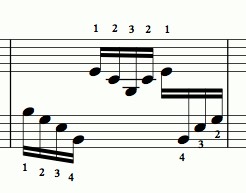I'm puzzled by the bar ringed in red from a piece for Celtic harp (La danseuse T'ang, in Images de Chine, by Monique Grabus).

There are two sets of beams, and every note has both an upward stem and a downward stem.
My harp teacher advises me to play it as a phrase flowing between the hands, which works fine; but I thought that would be notated like this:
 which is much simpler.
which is much simpler.
Is there a specifically French convention? or have I misunderstood what's intended?
The harp convention, as i understand it, is that notes to be played with the right hand are on the upper stave, which is why the E fourth from end of bar is on the upper stave.
